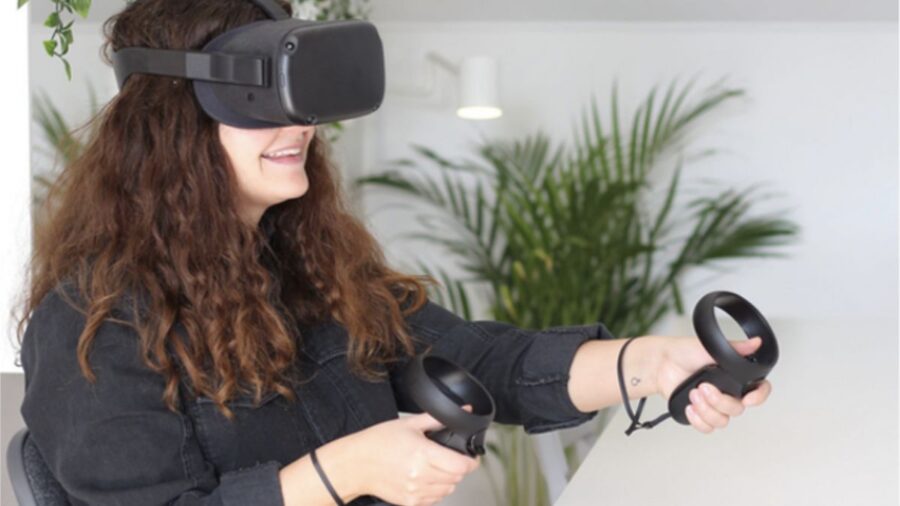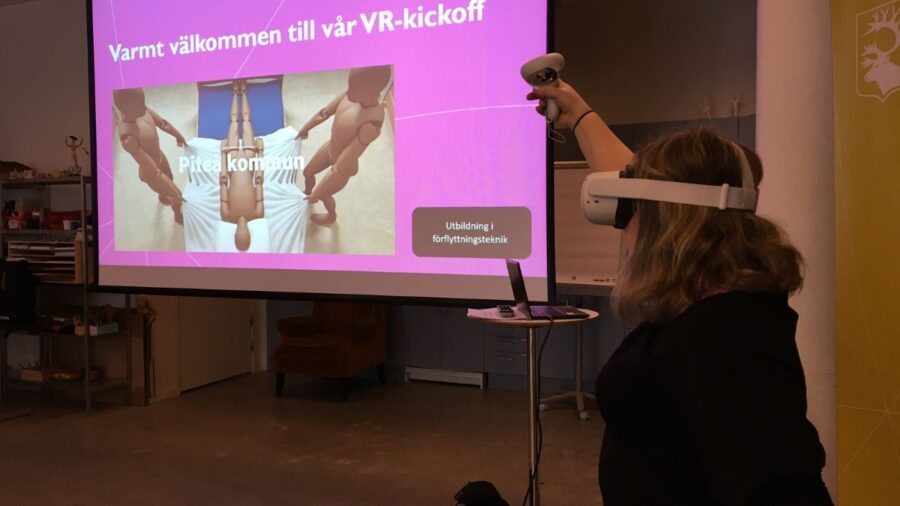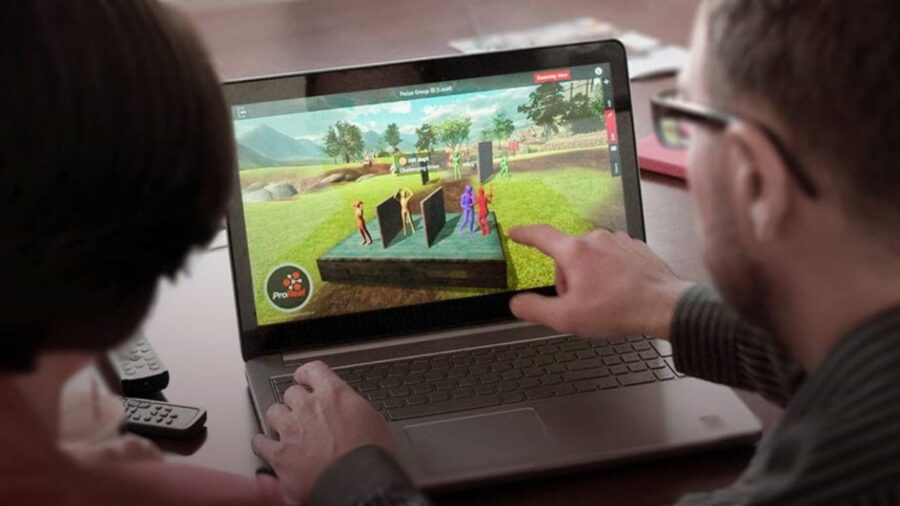
Virtual reality is proving to be a hit in human resources. Companies worldwide are turning to VR for training purposes and to gather staff feedback. VR, its champions argue, offers a safe, controlled environment where employees can practise different job functions, while the technology’s elements of gamification improve engagement.
That said, VR is in its infancy and there are still some creases to iron out.
Training in a virtual setting
Stockholm-based Warpin Reality and Oslo-based Attensi have used VR to design bespoke learning programmes across a host of sectors that include finance, retail, healthcare, hospitality and more.
Games trigger more parts of the brain than all other media
Users wear immersive headsets to navigate simulations which are intended to be as life-like as possible and created to suit a client’s particular needs. Recently, Attensi developed a virtual hospital triage department to train medical staff, while Warpin made an onboarding programme for PostNord, Sweden’s national postal service.
According to a 2020 study by PwC, companies can save up to 50% on their training costs by using VR (depending on the sector in which they operate), while onboarding processes can become up to four times faster, and work-related injuries can be cut by 45%.
Trond Aas, the chief executive of Attensi, points to the fact that VR offers both safety and flexibility. “Often there is a major benefit in the ease of access to training games across multiple devices,” he explains, “so you can play and repeat just as easily from your office desk as on the bus journey home. [Some] VR requires the physical aspects of space and the headset or glasses, but in the right circumstances, the immersive experience optimises the gameplay and learning.”
Is gaming good for you?
The gamified nature of VR-enabled training, Aas adds, taps into humans’ natural enjoyment of feeling they are getting better at something, as well as curiosities they may have about trying many different approaches to solving the same problem. “Games trigger more parts of the brain than all other media,” he claims. “They work with us on a human level, appealing to our desire to collect things, such as stars or rewards points, and they appeal to our desire to succeed, or even to compete with our colleagues on a leaderboard.”
One of Attensi’s other recent training programmes, Aas says, is a VR simulation the company designed for the Norwegian bank Eika. “It is a multi-skilled, multi-faceted training programme that immerses the user in an uncomfortable and challenging dialogue with a tricky customer who is determined to qualify for a loan.” The users are then exposed to “microaggressions, realistic escalations in tension and conflict resolution challenges”.

For a training programme like this, there is no one right answer. “You can fail the game because the customer becomes too angry,” Aas explains. “Basically, you have ‘collected’ too much anger on the anger scale whilst playing the game. Conversely, if you simply keep the client happy, you are not doing your job on meeting the necessary compliance standards.”
Repetition, Aas says, is a “cornerstone to progress in game-based training”. It is fuelled by the ambition to improve or to get a perfect score and earn rewards. With VR, he notes, there is also an enhanced exploratory element, thinking with the different choices you can make. “You are repeating the game but not always in the same way. What would have happened if I had chosen X or Y over Z?” A debrief with colleagues after the game, Aas suggests, can also add value to the learning process.
But Lisa Collinson, chief people officer at TheNextWe, an HR consultancy, is unconvinced. “VR is just that. It’s virtual,” she says. “I would ask: what tasks are repetitive nowadays? Every email? Every conversation I have? Every meeting? Repetitive in terms of frequency and timing, yes, but not in terms of content. I’ve worked in the learning and development space for 30 years and the cynic in me says e-learning was the unicorn of my time and e-learning still struggles as a concept, so no doubt VR will be the same today.”
How VR can help with difficult conversations at work
According to Andrew Jackson, VR has the potential to help navigate challenging interpersonal relationships. Jackson is the chief executive of Rethinkly, an Oxford-based firm, which he also co-founded. Rethinkly has developed a “VR world platform”, not unlike a computer game, and can count IBM and the NHS among its clients.
Where Warpin’s and Attensi’s technologies require some specialist kit, Rethinkly’s software is entirely screen-based and compatible with any computer with an internet connection. Rethinkly’s virtual world is reminiscent of a third-person role-playing game with graphics comparable to the Nintendo 64.
The Rethinkly platform is “not intended to be ultra-realistic”, Jackson clarifies. Rather, the programme invites users to create avatars, which can be customised to reflect emotions and convey typed speech, while being equipped with in-game props to help illustrate points.
Symbolism can cushion awkward chats
Some, such as an elephant, could be used to represent an elephant in the room, while a key and locked chest might be used to enhance a conversation about a pay rise. Jackson admits it’s a little on the nose, but is nevertheless convinced that “symbolism” is a good way of cushioning awkward chats.
Via the Rethinkly platform, colleagues can engage in either one-to-one or group interactions. They can do this remotely, from their respective homes, or as part of a human-led session in the office, where they are talked through in-game activities and exercises by a manager or HR professional.
Where traditional staff feedback forms or surveys risk being “limiting” in their “tick-box” nature, Jackson claims that the expanse of VR can facilitate more open and explorative communication.
Although Rethinkly’s technology is undoubtedly novel and intriguing, it would be a stretch to call it intuitive. Having sampled the platform, this reporter would suggest that the game’s “symbolism” is only effective insofar as each user agrees on what each avatar or prop represents. People, ultimately, interpret different things in different ways.

And where Jackson feels that VR provides a “distance”, which can remove people’s inhibitions, Donna Obstfeld, an HR consultant and business coach, wonders whether this is necessarily a good thing. “People can be cruel and vindictive,” she warns. “They are more inclined to say worse things when there is no real accountability. If people are hiding behind an avatar or dehumanising themselves, it can actually make them less empathetic.”
Obsfeld also questions whether removing conflict from the workplace is necessarily a positive goal to have in and of itself. She suggests that some conflict, if approached constructively, can help staff to “build resilience and function as healthy humans”.
VR’s role in improving employee engagement and morale
According to Warpin Reality’s chief executive and co-founder Emma Ridderstad, VR also has potential HR applications in helping staff to stay calm at work. Warpin offers a range of meditation programmes, she explains, which can offer workers a chance to “escape for a while”.
Meanwhile, Joseph Toma, the chief executive of another VR firm, Jugo, believes that the technology can help to foster greater collaboration and positive relationships between staff who may be based many miles apart.
VR can connect staff who may be based many miles apart
Like Rethinkly, Jugo is a VR platform which is screen-based and doesn’t require a physical headset. It is a software that allows its users to create highly interactive virtual conferencing environments, which aims to make video calls more engaging and replicate the feeling of being in the same room. It is particularly effective, Toma says, for staging digital events.
He points to Jugo’s project with Earls Restaurants, a Canadian chain with 70 sites across North America. “It’s about scalability and simplicity… [the tech] allowed for a large-scale, seamless gathering of participants from different geographical locations,” he says. “Despite the spread of employees, Jugo allowed them to share a single experience.”
Where this differs from a standard Zoom call, says Toma, is the event is heavily interactive. Noting the challenges of remote working, including holding staff’s attention when on a conference call, Toma explains that VR can be “beneficial for encouraging participation and ensuring that everyone is given a voice. Innovative platforms in this space, for example, enable users to leverage chat functions, launch poll questions and even participate in live audience Q&As with speakers ‘on-stage’.” Incorporating interactive elements into the structure of team meetings, he adds, is “essential when stimulating ideas and preventing loss of interest”.
A mixed approach
While there is plenty to be said for practising workplace scenarios in a controlled environment, companies that choose to adopt this form of training must accept the limitations of their own predictions. “People are human and will respond differently when faced with real life,” notes Obstfeld. “We all know how we hope we will react, but there is no guarantee that we will.”
Perhaps VR is better understood, then, as a complement to HR, rather than a replacement for it. All VR-enabled feedback sessions or events still need to be human-led. And, where possible, if face-to-face interactions can happen, they should.
